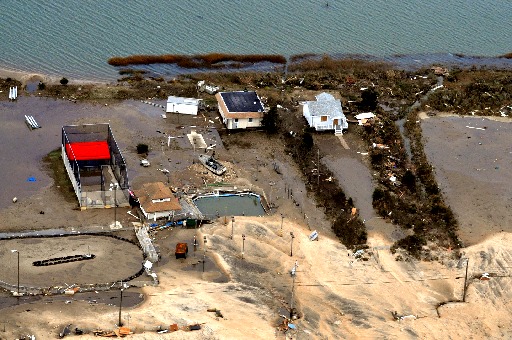Climate Change Partly to Blame for Hurricane Damage

CHARLOTTE, N.C. — Climate change likely made Hurricane Sandy much worse than it otherwise would have been, scientists said here yesterday at the annual meeting of the Geological Society of America.
For one thing, rising sea levels set the stage for a more damaging storm surge, as Hurricane Sandy broke records with a 13.2-foot (4 meters) storm surge in New York City's Battery Park, said Pennsylvania State University climatologist Michael Mann.
"At least 1 foot of those 13.2 feet was arguably due to sea-level rise," he said. That's because sea levels are 1 foot (30 centimeters) higher than they were a century ago, he continued.
Sea surface temperatures off the East Coast also contributed to the flooding. Giving rise to above-average levels of water vapor, they helped intensify the storm and produce more rain, he said.
Warmer-than-usual temperatures over Greenland also played a role, said George Stone, a researcher at Milwaukee Area Technical College.
A high-pressure system over the huge island helped to "block" the North Atlantic, pushing the hurricane toward the East Coast, according to researchers. Typically, scientists say, the jet stream instead carries hurricanes eastward into the Atlantic Ocean.
Temperatures in the Arctic have increased dramatically in recent years, scientists say. This summer, a record-breaking, Arctic sea-ice melt stretched across a larger area than any previously measured. Greenland also set records in August with massive melting of its glaciers.
Get the world’s most fascinating discoveries delivered straight to your inbox.
"If [Sandy's] left turn was indeed due to re-distribution of air masses and position of the jet stream, and that in turn was due to Arctic warming, then we might attribute a large part of Sandy to climate change," Stone said.
Of course, climate change did not create Hurricane Sandy, Mann said. Hurricanes and tropical storms would occur with or without global warming. But many climate models suggest that such storms will become more intense as the planet warms, he said.
Researchers at a special session on Sandy added that the effects of Hurricane Sandy may be felt for quite some time. Several researchers mentioned that the geography of New York made it more susceptible to storm surges. The long and narrow shape of the Long Island Sound, for example, helped to channel the storm surge and make it bigger. Additionally, areas like Battery Park were built from landfill and thus are low-lying and flat. [On the Ground: Hurricane Sandy in Images]
Reach Douglas Main at dmain@techmedianetwork.com. Follow him on Twitter @Douglas_Main. Follow LiveScience on Twitter @livescience. We're also on Facebook & Google+.

